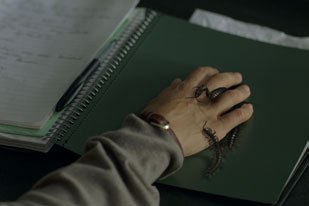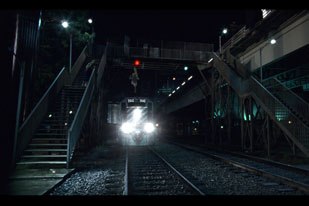J. Paul Peszko called up vfx supervisors Randy Goux and Patty Gannon to talk about the visual effects on the new horror film, One Missed Call.
Horror fans will be glad to see that Warner Bros. is opening the New Year (on Jan. 4) with One Missed Call, an all-new version of the Japanese hit, Chakushin Ari. I hesitate to use the term remake because, according to vfx supervisors Randy Goux and Patty Gannon of Zoic, Vancouver, the filmmakers barely watched the original. "The director (Eric Valette) wanted to create his own vision," states Goux. "We knew the whole theme, but there was no plan to do a remake of Psycho kind of thing where they did a cut-by-cut remake. This was almost a new version, a completely new movie."
Although visual effects played a very important role in adding suspense and terror, it was not planned that way. "He (Valette) wanted to be very, very subtle about the effects," Goux explains. "He didn't want to overpower it with CG. He wanted to use the characters to build the suspense. But with that said there are some key moments where he needed visual effects to tell that story. In the climax is where we really kicked in, but all throughout the movie there were points where visual effects added to that just ever so slight creepy moment."
This particular production is an excellent example of how people sometimes have a distorted view of CG and visual effects -- even people in the industry. "The director wanted to play things very subtly, and his comfort level with CG was not real high," adds Gannon. "In his mind, if you do CG, it's going to look like CG. So, that's why he was really trying to go practical on a lot of this stuff."
For this reason, unlike many horror films, One Missed Call did not start out with an emphasis on visual effects, but by the time the film was ready for release, it certainly had more than its fair share.

"I think we started off with about 50 shots," notes Gannon, "and by the time we were done it was close to three hundred effects."
A subtle vision can work very well in certain films, but that is not always the case. Sometimes a story needs to have those graphic moments, especially a horror film.
"He (Valette) was very subtle with all of his stuff, so far as what he wanted to see, what he felt was eerie," Gannon explains. "But, when the movie was first cut after shooting, he decided that there just weren't enough scare moments. That's when the (vfx) shot count really ballooned. When they decided that perhaps the very subtle approach wasn't the correct approach or the approach they wanted to go for."
In this case, seeing was believing. "Once we showed him we could do this photo real, it helped him a lot with his comfort level, and the vfx just ballooned from there."
The visual effects team wound up enhancing many of the scenes in post-production to add bigger scares. They took what were subtle moments that lacked impact and made them more effective if not graphic with the use of CG.
"There is quite a bit of face prosthetics that we literally replaced to make it, more effective, more scary and more impactful," Goux maintains. "All of the stuff you see with the girl in the hoodie -- we call her Monster Ellie -- all that stuff you see, the intention was to shoot it with an actress that had pretty extensive face prosthetics, but it just didn't have the impact it needed. So, we ended up replacing it all with a CG face."
Visual effects were used during post-production to not only enhance scary moments but to hint of things to come as Goux relates.
"(Shannyn Sossamon) is running down an abandoned burned-out hospital. It's very dark and she hears this banging, and all of a sudden something is trying to break through a metal door, and you just see imprints of somebody's head. That's what's making the banging. So we'd do all sorts of subtle visual cues that there is something very evil coming your way."
And, when the evil finally arrived, visual effects were needed to heighten the moment.

"There's a sequence where the actress is in a church, and she's standing up near the altar, and she feels the presence of something near her, and she ends up getting strangled, but nobody's really there," Goux continues. "But you can see a hand basically bulging out from inside her neck, strangling her."
It was another case of prosthetics replacement. Although the prosthetics used in the original shot worked to an extent, the impact left something to be desired.
"They actually had a rubber layer of skin, and somebody was down behind her and put their hand underneath that layer and bulged it out," Goux explains. "But yet, when it finally came to the edit, it didn't look like it had enough definition and didn't really look like it was being effective enough. So, they gave us a call and said, 'Hey, can you replace that? Can you make that look like a hand underneath her skin strangling her?' That was a pretty tricky one."
Tricky though it was, Goux managed to pull it off without a hitch.
"We basically created a whole new hand and neck. We took a CG hand as a base and used that to physically in CG displace the geometry (of the neck) and bulge it out. So, the technique was to do it just how you would think. Animate a hand that is strangling somebody and then let's shrink wrap some skin on top of that and blend it into the actual plate of the girl."
Among the 50 or so visual effects shots that were originally planned for the production, Goux is most proud of the opening title sequence.
"In the very beginning of the movie, there's a very stylized city fly through that Eric (Valette) wanted to get in, and it didn't have too much to do with the evil spirit, but it starts off on a nice calm courtyard and students walking. Then the camera starts to whip back and pull through twenty-five city blocks and ends up at a house on a hill. That's kind of a real big CG shot that we did. And it also does a time lapse of three days going back. So, everything speeds up real fast. You see cars whipping by, the sun coming up and down, up and down. It's real a neat shot."

Although CG and visual effects are being used more and more in pre-production to save both time and money, there was little previs on this film, at least not traditional previs.
"There's a sequence in the movie where one of the characters falls off a pedestrian overpass above some train tracks," explains Goux. "During pre-production, everyone needed to make a decision whether we were going to film an actual train going by and deposit greenscreen plates into that. So, we kind of helped that decision along. We went and filmed some train tracks in Vancouver, and we built a real quick CG train that had a nice handheld feel to it, and rendered it out and decided to start showing the director and the producers some train footage."
They said, "Yeah, That's looks great. That's what we want our train to look like."
"Yeah," said Goux, "that's not a real train. That's a CG train."
"So, it wasn't really the traditional previs route, but it helped production and saved money, and they had a lot more flexibility over how they could shoot that shot knowing that we could pull off a CG train by actually proving it."
When asked what was the most challenging aspect of this film, Gannon was quick to reply: "The changing landscape as far as what we were going to have to do. When the direction changes after everything has been shot is always difficult because you've got shot footage that you then need to reform into what they're looking for (she chuckles) after the fact. The hardest thing for us is the changing creative direction, which they relied on us heavily for. Basically they would put this in front of us and say this isn't scary. Do something with it, but our deadline's not going to change.
"That's always a tough thing. We were always comfortable with the number of effects and the level of effects, but it was just the changing creative direction so late in the game that was a real challenge."
"And to be able to react to that with CG resources is always a balancing act," adds Goux. "We're talking about the business side of it now, but it's kind of important to talk about sometimes."

And nothing can eat up those resources more than needing to change directions in a big way. In this case, it wasn't just a matter of enhancement but much more.
"There was big stuff added very late in the game like a photoreal baby. When you start adding characters like that, it's challenging," states Gannon.
"There's a very creepy moment, where she's (Shannyn Sossamon) running through that same abandoned hospital," Goux remarks, "and she hears a cell phone ring and she slowly walks into this room. The room is empty and it's all scorched out and there's a gurney in the middle of the room, and there's a babysitting in there. The baby turns and looks at her, and she's holding the cell phone that (Sossamon) thought she had destroyed. And there's definitely something wrong with that baby, and it's really creepy. It's not cute."
That's one dropped call that no one will miss. On the other hand, thanks to the visual effects team, One Missing Call is now missing very little in the way of impact. Ramping up those subtle moments with needed shock value illustrates how visual effects can improve a story and deepen an audience's emotional involvement.
J. Paul Peszko is a freelance writer and screenwriter living in Los Angeles. He writes various features and reviews, as well as short fiction. He has a feature comedy in development and has just completed his second novel. When he isn't writing, he teaches communications courses.








